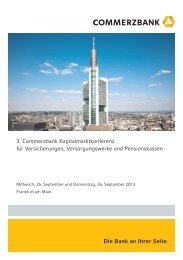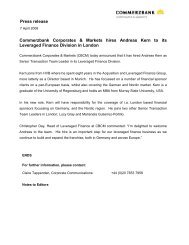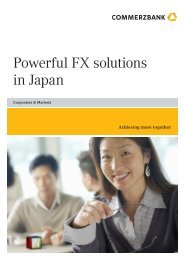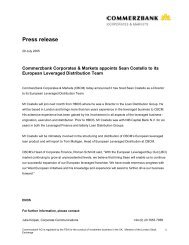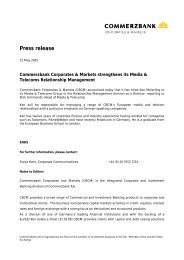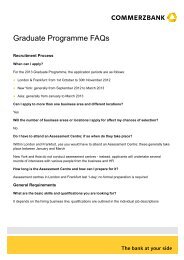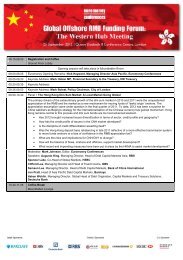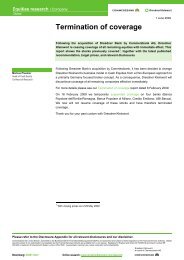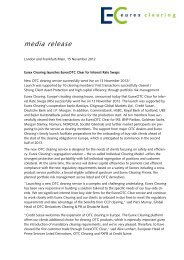The evolution of an asset class - Commerzbank - Commerzbank AG
The evolution of an asset class - Commerzbank - Commerzbank AG
The evolution of an asset class - Commerzbank - Commerzbank AG
Create successful ePaper yourself
Turn your PDF publications into a flip-book with our unique Google optimized e-Paper software.
COMMERZBANK<br />
<strong>The</strong> <strong>evolution</strong> <strong>of</strong><br />
<strong>an</strong> <strong>asset</strong> <strong>class</strong><br />
Discussing <strong>an</strong>d defining the development <strong>of</strong> FX as <strong>an</strong><br />
<strong>asset</strong> <strong>class</strong> – <strong>an</strong>d what this me<strong>an</strong>s for investors.<br />
Jessica James<br />
HEAd Of tHE QuANtitAtivE<br />
SOlutiONS GROup
pERSpECtivES COMMERZBANK<br />
“It took over a century for<br />
the equity <strong>asset</strong> <strong>class</strong><br />
to evolve into the liquidly<br />
traded indices we see<br />
today. FX has m<strong>an</strong>aged<br />
it in a decade.”<br />
We all know what <strong>an</strong> <strong>asset</strong> is. It is <strong>an</strong> equity, or a<br />
bond, or a commodity. Perhaps it falls into the<br />
‘alternatives’ bracket, like real estate or beautiful<br />
paintings. But FX? How c<strong>an</strong> the exch<strong>an</strong>ge rate<br />
between two currencies be called <strong>an</strong> <strong>asset</strong>? And<br />
yet it is now widely regarded as <strong>an</strong> <strong>asset</strong> <strong>class</strong> in<br />
its own right. All <strong>of</strong> our pension schemes are likely<br />
to have a few percent allocated to the FX <strong>asset</strong><br />
<strong>class</strong>; by m<strong>an</strong>y measures, it performed better th<strong>an</strong><br />
equities during the 2008 crisis. How did a set <strong>of</strong><br />
exch<strong>an</strong>ge rates turn into <strong>an</strong> investment?<br />
<strong>evolution</strong> oF FX as <strong>an</strong> <strong>asset</strong> <strong>class</strong><br />
Let’s consider the history <strong>of</strong> FX. While interest<br />
rates were recorded in <strong>an</strong>cient Egypt, <strong>an</strong>d credit<br />
derivatives were used to fin<strong>an</strong>ce 14th century<br />
trading ships, the first time that FX rates were<br />
freely floating instruments was in the post-<br />
Bretton-Woods era, after the 1970s.<br />
Global FX turnover<br />
USD trillion<br />
4.5<br />
4<br />
3.5<br />
3<br />
2.5<br />
2<br />
1.5<br />
1<br />
0.5<br />
0<br />
1989 1992 1995 1998 2001 2004 2007 2010<br />
Source: B<strong>an</strong>k <strong>of</strong> international Settlements, June 2012<br />
This new market rate was controversial. How<br />
would it evolve? Initially it was assumed that it<br />
would be determined either by interest rates <strong>an</strong>d<br />
inflation (higher yielding countries would have<br />
weaker FX rates) or by the prices <strong>of</strong> similar<br />
baskets <strong>of</strong> goods in different countries (they<br />
should cost the same after currency conversion).<br />
But it soon became clear that while volatile <strong>an</strong>d<br />
individual, FX rates displayed patterns which<br />
allowed the savvy trader to make money – <strong>an</strong>d the<br />
era <strong>of</strong> currency trading for pr<strong>of</strong>it could begin.<br />
In the 1980s, currency traders discovered trends.<br />
Trending behaviour occurs when <strong>an</strong> FX rate moves<br />
in the same direction for some time, possibly due<br />
to long-term economic divergencies between<br />
economic regions. It was a gift to traders –<br />
forecasting became easy. As the decade<br />
progressed, the FX carry trade also became<br />
popular. This took adv<strong>an</strong>tage <strong>of</strong> the fact that FX<br />
rates did not usually move to c<strong>an</strong>cel out the<br />
potential pr<strong>of</strong>it which could be made by<br />
borrowing in a low yield currency to invest in a<br />
higher yielding one. Doing this trade allowed the<br />
trader to accumulate steady pr<strong>of</strong>its over time.<br />
How to invest in FX<br />
In the 1990s, dem<strong>an</strong>d rose for structures which<br />
would open up the FX world to the investment<br />
community. Essentially, capital needs to be<br />
supplied to cover the various risks associated<br />
with <strong>an</strong> FX trading strategy (drawdown, credit,<br />
etc) <strong>an</strong>d is then held in <strong>an</strong> account which buffers<br />
a set <strong>of</strong> trades. This principle has been used to<br />
create swaps, notes, funds, m<strong>an</strong>aged accounts,<br />
hybrid <strong>an</strong>d option structures, <strong>an</strong>d m<strong>an</strong>y more<br />
deal types, all <strong>of</strong> which derive from the same<br />
underlying principle – to allow investors to<br />
benefit from the predictability <strong>of</strong> exch<strong>an</strong>ge<br />
rate movements.<br />
it’s a massive market<br />
<strong>The</strong> <strong>an</strong>nual turnover in FX is measured every<br />
three years by the B<strong>an</strong>k <strong>of</strong> International<br />
Settlements. In the chart we c<strong>an</strong> see how the<br />
market has rocketed to prominence, unchecked<br />
by global crises. <strong>The</strong> axis is in trillions <strong>of</strong> USD.<br />
wHat Do we see toDay?<br />
While the popularity <strong>of</strong> FX as <strong>an</strong> <strong>asset</strong> <strong>class</strong><br />
continues, the focus has ch<strong>an</strong>ged. Disillusioned<br />
investors are rejecting highly complex strategies<br />
which are vulnerable to ch<strong>an</strong>ges in the global risk<br />
environment. <strong>The</strong>se days it is more popular to<br />
invest in thematic strategies which give exposure<br />
to a region, like Asia, while fully exploiting the<br />
liquidity <strong>an</strong>d low trading costs <strong>of</strong> the FX world.<br />
FX vs traDitional <strong>asset</strong> <strong>class</strong>es<br />
It’s clear from our discussion that the value <strong>of</strong> <strong>an</strong><br />
FX investment is not found in the underlying<br />
rates themselves, but rather in the rules used to<br />
trade them. This is less unfamiliar th<strong>an</strong> it may<br />
seem. An equity index like the DAX ® has rules for<br />
entry <strong>an</strong>d exit; in effect it is a trend-following<br />
strategy: comp<strong>an</strong>ies enter as they gain in value<br />
<strong>an</strong>d exit as they fall in value. What is different<br />
about FX is the speed <strong>of</strong> development <strong>of</strong> the<br />
market. It took over a century for the equity <strong>asset</strong><br />
<strong>class</strong> to evolve into the liquidly traded indices we<br />
see today. FX has m<strong>an</strong>aged it in a decade. <strong>The</strong><br />
future will be interesting. JJ
PersPectives<br />
Disclaimer<br />
This document has been created <strong>an</strong>d published by<br />
the Corporates & Markets division <strong>of</strong> Commerzb<strong>an</strong>k<br />
<strong>AG</strong>, Fr<strong>an</strong>kfurt/Main or the group comp<strong>an</strong>ies<br />
mentioned in the document (“Commerzb<strong>an</strong>k”).<br />
Commerzb<strong>an</strong>k Corporates & Markets is the<br />
investment b<strong>an</strong>king division <strong>of</strong> Commerzb<strong>an</strong>k,<br />
integrating research, debt, equities, interest rates<br />
<strong>an</strong>d foreign exch<strong>an</strong>ge.<br />
This is a fin<strong>an</strong>cial promotion/marketing<br />
communication (together “communication”). It is<br />
not “investment research” or “fin<strong>an</strong>cial <strong>an</strong>alysis” as<br />
these terms are defined in applicable regulations.<br />
Material contributed by research <strong>an</strong>alysts is not<br />
issuer specific nor intended to be presented as<br />
independent fin<strong>an</strong>cial <strong>an</strong>alysis. <strong>The</strong> views in this<br />
communication may differ from the published<br />
views <strong>of</strong> Commerzb<strong>an</strong>k Corporates & Markets<br />
Research Department <strong>an</strong>d the communication has<br />
been prepared separately <strong>of</strong> such department.<br />
This communication may contain short term<br />
trading ideas. Any returns or future expectations<br />
referred to are not intended to forecast or predict<br />
future events. Any prices provided herein (other<br />
th<strong>an</strong> those that are identified as being historical)<br />
are indicative only, <strong>an</strong>d do not represent firm<br />
quotes as to either size or price.<br />
This communication is for information purposes<br />
only. <strong>The</strong> information contained herein does not<br />
constitute the provision <strong>of</strong> investment advice. It is<br />
not intended to be nor should it be construed as <strong>an</strong><br />
<strong>of</strong>fer or solicitation to acquire, or dispose <strong>of</strong>, <strong>an</strong>y <strong>of</strong><br />
the fin<strong>an</strong>cial instruments <strong>an</strong>d/or securities<br />
mentioned in this communication <strong>an</strong>d will not form<br />
the basis or a part <strong>of</strong> <strong>an</strong>y contract.<br />
Any information in this communication is based on<br />
data obtained from sources believed by<br />
Commerzb<strong>an</strong>k to be reliable, but no<br />
representations, guar<strong>an</strong>tees or warr<strong>an</strong>ties are made<br />
by Commerzb<strong>an</strong>k with regard to the accuracy,<br />
completeness or suitability <strong>of</strong> the data.<br />
<strong>The</strong> past perform<strong>an</strong>ce <strong>of</strong> fin<strong>an</strong>cial instruments is<br />
not indicative <strong>of</strong> future results. No assur<strong>an</strong>ce c<strong>an</strong><br />
be given that <strong>an</strong>y fin<strong>an</strong>cial instrument or issuer<br />
described herein would yield favourable investment<br />
results.<br />
This communication is intended solely for<br />
distribution to pr<strong>of</strong>essional customers <strong>an</strong>d/or<br />
eligible counterparties <strong>of</strong> Commerzb<strong>an</strong>k. It is not<br />
intended to be distributed to retail clients or<br />
potential retail clients. Neither Commerzb<strong>an</strong>k nor<br />
<strong>an</strong>y <strong>of</strong> its respective directors, <strong>of</strong>ficers or<br />
employees accepts <strong>an</strong>y responsibility or liability<br />
whatsoever for <strong>an</strong>y expense, loss or damages<br />
arising out <strong>of</strong> or in <strong>an</strong>y way connected with the use<br />
<strong>of</strong> all or <strong>an</strong>y part <strong>of</strong> this communication.<br />
Williams Lea Graphics, Presentations & Printing<br />
Art Editor Peter Barrell Designers Mark Vasey, Przemo Zwierzycki<br />
Pr<strong>of</strong>ile Photography George Chirayus Production Jackie Burke.<br />
Commerzb<strong>an</strong>k <strong>an</strong>d/or its principals or employees<br />
may have a long or short position or may tr<strong>an</strong>sact<br />
in fin<strong>an</strong>cial instrument(s) <strong>an</strong>d/or securities<br />
referred to herein or may trade in such fin<strong>an</strong>cial<br />
instruments with other customers on a principal<br />
basis. <strong>The</strong> information may have been discussed<br />
between various Commerzb<strong>an</strong>k personnel <strong>an</strong>d<br />
such personnel may have already acted on<br />
the basis <strong>of</strong> this information (including trading<br />
for Commerzb<strong>an</strong>k’s own account or communication<br />
<strong>of</strong> the information to other customers <strong>of</strong><br />
Commerzb<strong>an</strong>k). Commerzb<strong>an</strong>k may act as a<br />
market maker in the fin<strong>an</strong>cial instruments or<br />
comp<strong>an</strong>ies discussed herein <strong>an</strong>d may also perform<br />
or seek to perform investment b<strong>an</strong>king services<br />
for those comp<strong>an</strong>ies.<br />
No part <strong>of</strong> this communication may be reproduced,<br />
distributed or tr<strong>an</strong>smitted in <strong>an</strong>y m<strong>an</strong>ner without<br />
prior written permission <strong>of</strong> Commerzb<strong>an</strong>k.<br />
This communication or the m<strong>an</strong>ner <strong>of</strong> its<br />
distribution may be restricted by law or regulation<br />
in certain countries. Persons into whose<br />
possession this document may come are required<br />
to inform themselves about, <strong>an</strong>d to observe<br />
<strong>an</strong>y such restriction.<br />
By accepting this communication, a recipient<br />
here<strong>of</strong> agrees to be bound by the foregoing<br />
limitations.<br />
This communication is issued by Commerzb<strong>an</strong>k.<br />
Commerzb<strong>an</strong>k <strong>AG</strong>, London Br<strong>an</strong>ch is authorised<br />
by Bundes<strong>an</strong>stalt für Fin<strong>an</strong>zdienstleistungsaufsicht<br />
(BaFin) <strong>an</strong>d subject to limited regulation by the<br />
Fin<strong>an</strong>cial Services Authority. Details on the extent<br />
<strong>of</strong> our regulation by the Fin<strong>an</strong>cial Services<br />
Authority are available from us on request.<br />
Italy: You should contact Commerzb<strong>an</strong>k <strong>AG</strong>,<br />
London Br<strong>an</strong>ch if you wish to use our services to<br />
effect a tr<strong>an</strong>saction in <strong>an</strong>y <strong>of</strong> the fin<strong>an</strong>cial or other<br />
instruments mentioned in this communication.<br />
US: This document has been approved for<br />
distribution in the US under applicable US law by<br />
Commerz Markets LLC (“Commerz Markets”), a<br />
wholly owned subsidiary <strong>of</strong> Commerzb<strong>an</strong>k <strong>AG</strong> <strong>an</strong>d<br />
a US registered broker-dealer. Any securities<br />
tr<strong>an</strong>saction by US persons must be effected with<br />
Commerz Markets. Under applicable US law;<br />
information regarding clients <strong>of</strong> Commerz<br />
Markets may be distributed to other comp<strong>an</strong>ies<br />
within the Commerzb<strong>an</strong>k group. This report is<br />
intended for distribution in the United States<br />
solely to “institutional investors” <strong>an</strong>d “major U.S.<br />
With th<strong>an</strong>ks to the Perspectives Magazine Editorial Committee: David Clapham, Rainer Ernst, Enrico Ferr<strong>an</strong>te,<br />
Stef<strong>an</strong> Haupt, Karen Jones, Nash Jooma, Larissa Keown, Nora Kronem<strong>an</strong>n, Matthew Lowe, Iv<strong>an</strong> Mukadam, Sven Reuss,<br />
Harriet Rosewell, Claire Tappenden – <strong>an</strong>d to the Commerzb<strong>an</strong>k Corporates & Markets Communications Department<br />
<strong>an</strong>d Global Compli<strong>an</strong>ce.<br />
Photo credits: cover page: Getty, inside pages: Alamy 4, 10, 46, 48 corbis 27, 32 Getty 13, 17, 18, 24, 26, 28, 35, 40, 42, 44, 50, 52<br />
George chirayus 36, 38, 39<br />
Printed by sPM Lithographics Limited who hold the environmental accreditation isO14001 <strong>an</strong>d are Fsc certified. the material used is<br />
Heaven 42 which is a product group from well-m<strong>an</strong>aged forests <strong>an</strong>d controlled sources. the inks used are all vegetable oil based.



